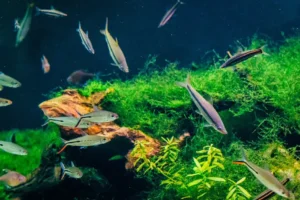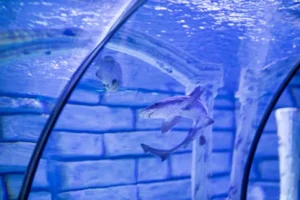
The Ultimate Guide to Saltwater Tank Setup for Beginners

Setting up a saltwater tank can be an exciting, yet overwhelming experience for beginners. This guide will provide you with the essential steps, tips, and tricks to help you create a thriving saltwater aquarium. Whether you’re drawn to the colorful corals or the variety of marine life, this ultimate guide will break down the process into easy-to-follow steps, ensuring that your journey into the world of saltwater tanks is both enjoyable and successful.
Understanding the Basics of Saltwater Tanks
Before diving into the world of saltwater tank setup, it’s crucial to understand what makes these ecosystems unique. Unlike freshwater tanks, saltwater aquariums require a different level of commitment and knowledge. Saltwater tanks replicate the natural habitats of marine life, and this involves maintaining a specific water chemistry that can be challenging for beginners.
One of the first things you’ll encounter is the term ‘salinity,’ which refers to the amount of salt in your water. The optimal salinity for most marine species typically ranges from 1.020 to 1.025 specific gravity. Monitoring salinity is essential as it affects not just the health of your fish but also the corals and other invertebrates you may choose to keep.
In addition to salinity, understanding the nitrogen cycle is vital. This cycle is crucial for maintaining a healthy environment in your tank. It starts with the decomposition of fish waste and uneaten food, which releases ammonia. Beneficial bacteria convert ammonia to nitrite and then to nitrate, which is less harmful to your fish. During this process, patience is key; cycling can take anywhere from a few weeks to several months depending on your setup.
Choosing the Right Tank Size and Location
The size of your saltwater tank is one of the most important decisions you’ll make. While a smaller tank might seem appealing due to lower setup costs, it’s often much more challenging to maintain stable water conditions. Larger tanks are generally recommended for beginners as they offer a more forgiving environment. A 50-gallon tank strikes a good balance between size and manageability.
Once you’ve selected a tank size, determining the right location is equally important. Choose a spot away from direct sunlight to minimize algae growth while ensuring easy access for maintenance. Keeping the tank near a power source is also essential, as you’ll be relying on various equipment to keep your tank healthy.
It’s also wise to consider the weight of the aquarium when filled with water. A gallon of saltwater weighs about 8.6 pounds, so a 50-gallon tank can weigh over 430 pounds when full. Make sure your chosen spot can support this weight and that there’s a sturdy stand designed for aquarium use.
Essential Equipment for Your Saltwater Aquarium
Having the right equipment is crucial for the success of your saltwater tank. First and foremost, you’ll need a high-quality filtration system. This not only keeps the water clean but also supports the nitrogen cycle we’ve discussed earlier. A canister or protein skimmer is ideal for removing organic waste and controlling nutrients.
Next, consider your lighting options. Corals and other photosynthetic organisms depend on adequate lighting to thrive. LED lights are a popular choice for many hobbyists due to their energy efficiency and adjustable spectrums. Choosing the right light can dramatically affect the health of your marine life.
Heating is essential too, especially if you’re keeping reef species. Marine life generally thrives in temperatures ranging from 75 to 82 degrees Fahrenheit. Ensure your heater is reliable and appropriately rated for your tank size to avoid temperature fluctuations that can stress your fish.
Don’t forget water testing kits! Regular testing for pH, ammonia, nitrite, nitrate, and salinity will help you maintain optimal conditions for your tank. Be proactive with testing, as these parameters can change rapidly.
Setting Up Your Saltwater Tank: Step-by-Step
Setting up your saltwater tank involves several key steps, starting with rinsing the tank and all equipment with fresh water to eliminate any dust or contaminants. Once cleaned, it’s time to add substrate to the bottom of your tank. A common choice is live sand, as it helps kickstart beneficial bacteria growth, which is essential for cycling your aquarium.
After the substrate, it’s time to add water. Use a marine salt mix to create the appropriate salinity. It can be helpful to prepare the saltwater in a separate container before adding it to avoid cloudiness in your tank. Once your water is in, run your filtration system for at least an hour before adding any decorations or rock work.
Decorating your tank with live rock not only creates a visually appealing environment but also serves as a natural filtration medium. Aim to create plenty of hiding spots for fish and invertebrates, while ensuring there’s ample open space for swimming.
Finally, allow your tank to cycle for several weeks. During this time, test your water parameters regularly and add beneficial bacteria to assist in establishing the nitrogen cycle. Once your levels stabilize, you can begin introducing your first marine life to the tank.
Understanding Water Chemistry and Maintenance
Maintaining the right water chemistry is paramount for the health of your saltwater tank. Key components to monitor regularly include pH, ammonia, nitrite, nitrate, salinity, and alkalinity. Each of these parameters plays a vital role in the overall health of your aquarium.
For instance, the ideal pH for a saltwater tank typically falls between 7.8 and 8.5. Regularly testing and adjusting pH levels will help prevent stress on your fish and corals. Similarly, ammonia levels should remain at an undetectable level, as even small amounts can be toxic to marine life.
Another critical aspect of maintenance involves performing regular water changes. A good rule of thumb is to change about 15-20% of the water every two weeks. This helps remove nitrates and replenish essential minerals, contributing to a healthier ecosystem.
Having water tests and monitoring equipment such as a refractometer to measure salinity and a reliable test kit for other parameters will make this process easier and more effective. Keeping a close eye on your water chemistry will allow you to detect issues before they become serious problems.
Choosing the Right Marine Life: Fish and Corals
Choosing marine life for your saltwater tank is both exciting and challenging. Start by researching fish species that are compatible with each other and with your tank size. For beginners, hardy fish like clownfish, damselfish, and royal gramma are excellent choices due to their resilience and ability to adapt.
When it comes to adding corals to your aquarium, start with easier options like soft corals, which are relatively more forgiving than hard corals. Examples include zoanthids and leather corals. These corals not only add beauty to your tank but also support the natural ecosystem.
Compatibility is crucial; ensure that the fish and corals you select will not harm each other. Researching the specific needs of each species can save you a lot of trouble down the road. Additionally, consider your tank’s bio-load, or the number of organisms your tank can support without compromising water quality.
Common Mistakes to Avoid in Saltwater Tank Setup
As with any hobby, beginners often trip over common pitfalls. One major mistake is adding fish too quickly after setting up the tank. The nitrogen cycle must fully establish before adding any marine life, which can take weeks or even months depending on various factors. Going too fast can lead to disastrous consequences.
Another common error is overfeeding fish. It’s tempting to give them extra food when they appear hungry, but this can lead to water quality issues that affect not just your fish but the entire ecosystem. Stick to recommended feeding schedules and portion sizes.
Failing to maintain your equipment is yet another misstep. Regularly check and clean your filters, heaters, and pumps. A breakdown in any of these systems can create significant problems in your tank.
Resources and Communities for Saltwater Tank Beginners
Getting involved in the saltwater aquarium community can be incredibly rewarding. Online forums and social media groups are fantastic places to connect with experienced aquarists who can provide invaluable advice and support.
Books and tutorials specifically focused on saltwater tanks are another great way to deepen your understanding. Many well-respected authors and hobbyists share their expertise in guides that cover everything from basic setups to advanced techniques.
Local aquarium clubs can also provide resources and opportunities for networking. Attending club meetings or events can help you gather firsthand knowledge while meeting other enthusiasts who share your passion.
Wrapping Up Your Saltwater Tank Journey
By following the steps outlined in this guide, you’ll be well on your way to establishing a beautiful and healthy saltwater tank. Remember, patience and careful planning are key components to a successful aquarium. Don’t hesitate to reach out for help or consult expert resources as you embark on this exciting adventure in marine aquatics.
Latest Post


Transform Your Space with an Exotic Aquarium Display

12 Exotic Saltwater Fish Every Enthusiast Should Know About

Why Are Saltwater Systems Preferred for Luxury Fish Tanks?
Create Your Underwater paradise today
Start your journey to a stunning saltwater aquarium today. Our experts at Mikalyzed Exotic Aquariums are here to bring your vision to life.

